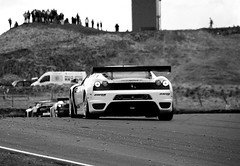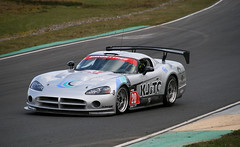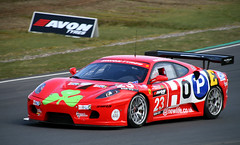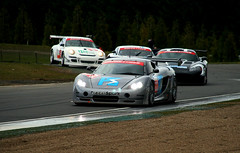Reading the Runes
If the Spanish Grand Prix was in any way significant, it was for what it seems to tell us about the rest of the season. One of the ongoing question marks about 2008 is just what the extent of Ferrari's advantage actually is. Everyone, it seems, is in agreement that Maranello have produced the best car on the grid. What is much harder to determine is just what margin of superiority they enjoy over the opposition. Winter testing suggested it might be huge. The Australian Grand Prix, on the other hand, left us wondering whether they had the quickest car at all. Bahrain, and in particular, Malaysia, will have reassured them on that score.
Those are odd races, though. Australia is a street circuit, and the track was unexpectedly 'green' owing to overnight rain. Malaysia and Bahrain are undoubtedly affected by the heat, while the latter was Ferrari's testing destination of choice over the winter. The Spanish Grand Prix perhaps gives us the most accurate picture we have yet had of where the teams stand relative to each other.
It's a circuit which all the teams test at constantly. Everyone on the grid will have a reasonable working set-up, and the drivers know the place like the back of their hand. On top of that, it's fairly typical circuit - not a Monza, a Monaco or a Montreal. If you're quick here, you really should be on the pace almost everywhere. It is as close as we get all year to a simple test of the relative out-and-out pace of each of the teams.
So what did it tell us? Well, it would seem that Ferrari are indeed a step ahead of their main rivals, but there isn't nearly as much in it as we might have thought. In qualifying, the Ferraris were a shade quicker than the Mclarens and the BMWs, but then they were also fueled a lap or two lighter than Hamilton or Kubica (Kovalainen's shunt leaving us unsure as to how much heavier Heidfeld and Kovalainen himself were, as a safety car intervened). Although the question of just how good a lap each of Hamilton, Raikkonen and Kubica strung together remains unanswered, the times tend to suggest that, on qualifying pace, the Mclaren and the BMW are much of a muchness, and within about 0.2s of the Ferrari.
Now a margin of 0.2s is interesting, because it suggests that, while Ferrari may be the team to beat, Mclaren and BMW are close enough that, should the Scuderia stumble, or should the track simply not suit their car, any of Kovalainen, Hamilton, Kubica and Hamilton might be in a position to take advantage. It may be Maranello's year, but we are not looking at a repeat of 2002 or 2004. A margin of a couple of tenths a lap is also the kind of gap that a particularly inspired bit of driving might be sufficient to overcome - especially when qualifying and track position are so crucial to the outcome of the race. In the modern era, it might be hard for even the best driver to overcome a performance deficit in their car, but if the car disadvantage is small enough, it is not impossible (just look at the variations in pace between team mates, which can easily exceed 0.2s).
All this, of course, counts for little if Ferrari's race pace advantage greatly exceeds their qualifying pace advantage. It has been suggested that, while the Ferrari F2008 struggles to generate sufficient heat in its tyres over a single lap, it is much much kinder to its rubber over a whole stint than the Mclaren and, especially, the BMW. Before the Spanish Grand Prix, I would have been inclined to agree, but I'm no longer so sure. After all, the Ferraris of Massa and Raikkonen were rarely more than 5 seconds or so up the road from Hamilton's Mclaren, and the BMW of Kubica had no difficulty staying on in touch either (that despite the fact that the BMW, in particular, had a reputation early in the season for eating its tyres). Now it could be that the Ferrari pair were taking it easy - not pushing as hard as they could have done - and certainly Kimi Raikkonen's fastest lap at the very end of the race hints that this was in fact the case. On the other hand, if the Ferrari duo were pushing only as hard as they needed to, wouldn't they have built up a slightly larger margin than they did. A five second lead, after all, is not going to be enough to allow a driver to stay in front in the event of even a brief off-track moment (and let's face it, Felipe Massa has had a few of those this year). If Massa and Raikkonen could have done so, surely they would have stretched the gap to a more comfortable 10 or 20 seconds?
The other major point of interest last weekend was, of course, the pace of former World Champion Fernando Alonso's Renault at his home race. After struggling to make the top 10 in Bahrain (despite a bit of attrition up ahead) Alonso shocked everyone by getting the Renault onto the front row, just a tenth of a second slower than Raikkonen's pole-winning Ferrari. OK, so he was fueled light (Joe Saward was particularly scathing of Renault's approach over at grandprix.com) but he wasn't fueled as much lighter than his rivals as we might have feared. He pitted three laps before Massa and four before Raikkonen. Enough to explain how he was able to get ahead of the Mclarens and split the Ferraris, but not enough to explain the massive leap he and the team appear to have made since Bahrain, when he was 2 seconds away from the pole. On the admittedly very rough assumption that each extra lap of fuel slows a car by around a tenth of a second, it appears that Renault, at least when Alonso is behind the wheel, are about two or three tenths of a second a lap off the pace of BMW and Mclaren, perhaps even a little less.
It's hard to know if the Enstone team, whose budget is not in the same league as the three teams up at the very front, can keep up this rate of progress. On the other hand, in Fernando Alonso, they have, to my mind, probably the best all-rounder in F1 today, and there is little doubt that Renault is one of the most closely knit teams on the grid - a group of real racers who are able to go about their business with relatively little interference from the parent company. It will be a tall order for them to find race winning pace, but I wouldn't quite rule out the possibility.
We may not be on course for the epic season-long battle we saw last year between Ferrari and Mclaren. I can't help thinking that, over the balance of the season, Ferrari will prove to be a little too far ahead for that. On the other hand, when it comes to individual races, things could be a good deal more interesting this year. BMW's pace suggests that they really are close enough to the pace to pick up a victory if the cards fall right for either Heidfeld of Kubica this year. Mclaren certainly have race-winning pace, if the circuit suits them, and with Alonso at the wheel, Renault might at least be quick enough to crash the party whenever any of the big three teams stumble. I'm not sure we're in for a classic F1 title battle of the kind we saw last year, but, however dull the Spanish Grand Prix might have been as a race, it hints that we could still be in for an interesting season.
Labels: barcelona, felipe massa, ferrari lewis hamilton, formula 1, heikki kovalainen, kimi raikkonen, robert kubica, spanish grand prix








